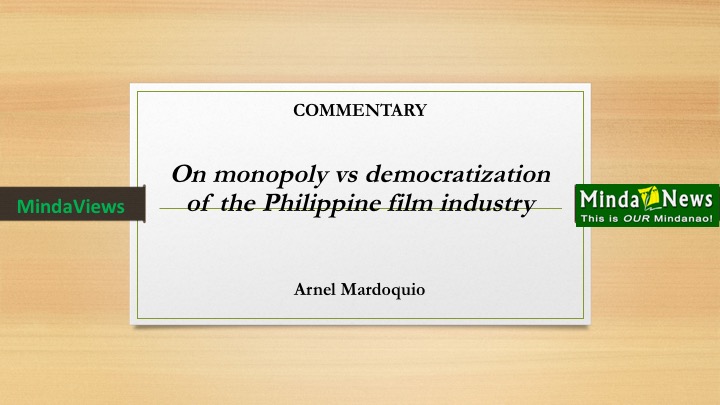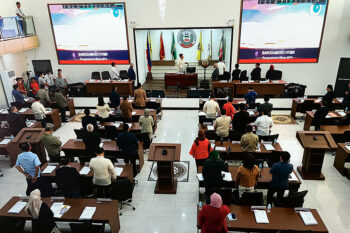
(English translation by Erico San Pedro)
Three years ago, I wrote this paper and gave the first draft to two of my Metro Manila-based director-friends. Though still unpolished, they brought the paper to the office of one senator. As expected, a topic that dealt with the disassembling of a huge monopoly system in any industry was controversial and therefore, not appreciated. The lawyer-members of the senator’s staff never saw anything wrong with the film industry in the Philippines. They talked more about tax incentives, plus other “Band-Aid” measures. They reasoned that, that was the only path, as there was really no great problem.
With new developments in the industry, I revised the paper, hoping to inspire new independent filmmakers who were starting to organize themselves into groups with the same sentiment. To them, the time has come to really face the ills facing the industry. My thoughts are with them as I believe that we cannot expect anything from a government agency that, tasked with seeing through the film industry’s development, is more into glamour poses in order to cover up its incapability. Instead of helping with the evolution of a local film industry, it has even assisted in its demise.

I do not need to be a scholar armed with academic expertise to see and analyze the happenings in the industry, and this is not even a scholarly thesis. As a legitimate industry worker, I attest that all these problems exist.
In my ten years of making films, I have seen from fellow independent filmmakers how the existing monopolistic system has manipulated the business of selling films in the country and further diminished the rise of a true Philippine film industry.
I first wrote this in Visayan, then in Tagalog for my fellow workers to read, and eventually had it translated in English through Erico San Pedro who was an editor in one of the cultural publications during our active time in cultural work in Mindanao. Currently, we are co-authors in a paper on the study of the economic potentials in Filipino independent films once they have reached the formal market, i.e., the economic power and potential of independent films as products and services that aid our economy as a whole.
We submit this paper to Congress through Bayan Muna Partylist in the hope that it be put into law, with the wish that as such the establishment of a Filipino film industry would be initiated in our lifetime.
Independent Cinema as an Underground Economy in the Philippines
By all definitions, the independent cinema is a qualified example of what an industry is. For one, it is involved in a dynamic economic activity composed of local talent, and a workforce that manufactures a popular and marketable local product. Its contribution may appear trivial compared to its dominant counterpart, but on the whole, it greatly helps the local economy. Surely there are records kept by producers which show in detail the expenditures of every production. Their list will show the countless payments for talent fees, van rentals, purchases of kilometers of cloth, fish and meat for crew and cast meals, all from the local markets in small towns. The list will likewise include “ukay-ukay” forays, and salaries for small town electricians, carpenters, masons and architects; all vital components for a hometown local production. Small hotels and inns in the regions and provinces have also benefited from the independent cinema’s on-site presence. Production and shooting schedules in the provinces veer away from the locale’s calendared festivals. As such, the locality benefits greatly for the off-season presence of their outfits. You could say that in these instances, the independent cinema is the clientele during the dry season of local tourism. On a yearly basis, this is a regular cycle of economic activity.
The Independent Cinema movement in the Philippines produces about a hundred films in a year. The quality of their films has garnered countless praises and awards from all over the world, and along with this, evolved an expertise that has led to the blooming of an underground economy. In turn, this underground economy directly contributes to a definite economic activity. The independent cinema is considered an underground economy in the Philippines as it does not directly pay the amusement taxes for most of the films that are produced. The reason for this is that formal venues, such as movie theaters are not available to them. Despite this, the independent cinema has proven time and again that during recent film festivals in Manila, its hit-and-run series of films, with their limited screening time and limited number of theatre houses given to them by theatre owners and associations have earned hundreds of millions in gate sales. There have been several independent films productions that have attempted to enter the market and have succeeded. This concrete experience only proves that the independent cinema is a force to reckon with economically.
The indirect way by which independent cinema is taxed, is on the logistics aspect of its operations. Its technical department is constantly updating its wares, from expensive cinematic lenses and cameras, rolls upon rolls of cable, special microphones, sound recording gadgets, and so on. They are active purchasers of the latest computer software, laptops, desktops, and other equipment which when added as a whole, run up a huge expense. To top it all, these equipment need to be updated from time to time. As such, their expenses as consumers are the ways by which they are pay tax.
It has thrived despite more than a decade of inattention by past government administrations. As such, the Independent Cinema’s challenge for the present administration is the establishment of a genuine film industry in our country.
In spite all these, the independent cinema will remain an underground economy unless the present government does something. Surely, with such vibrant economic force that is active in both the cities and the regions, isn’t it time we have a national film industry?
Film Trade in Ph: not an industry but a monopolistic system of trade
In contrast to the dynamic character of the independent cinema, the owners and proprietors of theater houses have designed a system that runs contrary to the concept and essence of what an industry is. The importation of foreign films and the unloading of ninety percent finished products in the local film market are not the markings of an industry. These are simply the actions that are indicative of a business chain, and it is killing the local film industry. More important, it brings to the surface the discriminatory nature of this so-called industry. Hollywood blockbuster films treated as first class, is given priority in this market. Second class position is given to local studio-based film productions that churn out Tagalog films. The independent cinema is not in their league. According to them, the art of the “indies” is not for the market because it only messes up with their already-functional system of things.
The state of the Philippine film business can simply be described as one that runs on greed for sales and profit. Our present market is an exclusive playground for theater owners. They have a tight relation with the people who bring finished products or films from Hollywood. As a result, this aggrupation has instinctively monopolized the market. Their exclusive association has only firmed up their manipulation and corruption. These are the monopolists; they are the oligarchs in the film business of the Philippines.
The Philippines has long adhered to the changes in the configuration of global distribution of commodities. This business design, where retail and entertainment are included, has given birth to the one-stop shop concept. This new face of business has led to new concentration of capital, and the film industry is not exempted from this. Rich monopolist businessmen, who have shares in mining, airlines, banking and finance, communications, mass media, electricity, real estate, and the retail business, have ventured into the establishment of shopping malls as well. This one-stop shop cum entertainment venue is the funnel by which all are sucked into.
In this situation, he who owns the bigger center of business holds the most control. A piece of film is a simple product like any other, so much like the toothpaste displayed in a gondola at any supermarket. If you have a product to sell, and you want to compete with others, a space in the mall is the ideal spot. The transaction is much like real estate; the value of rent is measured according to the per square inch space you wish to occupy. Rent is charged from the opening up to closing time. The establishment takes charge of your product’s sale, with you only providing promotional collaterals and other materials that will ensure the speedy “sale” of your product. It is likewise their decision how long you can stay at the expensive space you are renting. Their operation is both extensive and far-reaching. The mall owners, most of whom are also owners of other large industries in the country, backed up the theatre operators to strengthen the monopoly in the industry.
This monopolistic practice in the film business not only kills the Philippine film industry as a whole, it strikes deep into the heart and soul of a country represented by our quality films made by Filipino filmmakers.
The misnomer that is Filipino Mainstream Cinema
Hollywood blockbuster films and the monopoly system rule the waves deep into the consciousness of the market today. This is the primary product that is fed into the market for those who frequent the movie houses in the malls. The direct result of this is the disintegration and weakening of the Filipino Mainstream cinema.
The mainstream movie industry has all but folded up, with film workers seeking new job ventures, amidst a burgeoning television industry. So, if we give credence to the question whether there really is such a thing as a Filipino Film Industry, the answer is no. Ninety percent of the films in the market today are not made in the country, and most of the quality films made by local filmmakers are not shown in our venues. Thus, the tag of Filipino Mainstream Cinema in this present market is a misnomer, as it virtually does not exist.
Yet, is the presence of Tagalog films in the mainstream market not an indication of a Filipino mainstream industry?
At first glance, Tagalog studio-based film productions seem like an established mainstream industry because of the mode and relation of production. However, everything is owned by the capitalist and everyone else is nothing but wage workers. While the workers go home after the day’s work, the capitalist takes the product which he presumes is exclusively his own. He mobilizes his playground market and shows the film product. As this makes money, a part of its sales will include the blood and sweat of the film worker.
In this exploitative system, the workers are nothing but second class citizens in the discriminative market of cinema.
The continuous outflow of Tagalog films by studio-based film productions in central Manila is not an indication of an industry. These are not permanent, with no sustained pattern. They are merely peddlers of their Tagalog films, yet whenever a big competitor from Hollywood enters the market, they lie low and wait for a better time to show their product. They are no different form the hawkers at Quiapo and Recto who, when there are law enforcers present, run away with their wares.
The hawkers do not have the resolve to seize the market because it has provided them with ample space to display their wares when it sees fit. They are at its mercy. These hawkers have embraced this exploitative system which they have inherited from the older industry. They are the willing victims, as they have been used to this corruptive setup. However, in instances when the monopolist business grants them permission to show their film outputs, they aggressively seize the moment, overwhelming whatever local competition is there at the moment; like the independent cinema, which may have happened to be in that market as they are. As Hollywood films squeeze hard on them, they do the same to the smaller and local outfits. This is the only way to maintain their temporary dominance over the cinema playing field. These hawkers are also like chameleons as they can change colors. If need be, they can shift-shape to appear like indie films, if that is what it will take to get through the market and make money.
The drama of these hawkers is now exposed for everyone to see. Sometimes, they castigate the monopolistic system whenever their films are discriminated on and not given ample showing schedules. However, if their films rake in great dividends at the gate, they heap praise on the same exploitative system. As such, in the continuing struggle by independent cinema, they cannot be turned into reliable allies against the ruling monopoly in Philippine cinema.
The curtain that has blocked our vision has fallen and the altercation does not lie between the mainstream and the indies. The real contradiction is between the monopolistic system and Independent Cinema.
FDCP as an instrument of the monopolistic businessmen and the hawkers
Because of the absence of a department in the government bureaucracy that oversaw to the needs of the film industry in the country, the Film Development Council of the Philippines (FDCP) was initially seen as the most capable agency that would fulfill that mandate.
If that mandate were only formulated with the right context and perspective, the FDCP would have had a meaningful contribution at resolving the roots of the problem which is the monopoly of the market against the democratization. This is the central contradiction now. This conflict is between two opposing interests; the monopolistic theater associations in their film business, and the Independent Cinema which espouses a democratic market and represents the free cinema industry.
By some misfortune, the agency has been remiss and this, we did not expect. The present commissioner is incapable of understanding the complicated problem. This, the FDCP now has become an apt instrument for the monopolistic business and their allies, the hawkers. The direction taken by Commissioner Liza Dino-Seguerra has been short of peddling the independent cinema in the playground of the greedy capitalists.
The independent cinema has two concrete proofs in its charges against the commissioner of the FDCP. First, it was clear that the commissioner had a hand in the lessening of the relative powers of the independent cinema in the Metro Manila Film Festival (MMFF) 2016 that would have opened up a fresh perspective for the said film festival. It should have been an initial shout out to the MMFF as it wallowed in the corrupt system.
It should have been the pre-requisite for a democratic market; the formal presentation of the independent cinema in the country. However, the heart and sentiment of the commissioner seemed to favor the interests of the monopolistic business and its hawkers. The result was the return to the old ways, where what ruled was the monopolist system in the market.
The greatest offense of the commissioner now is her new project, the PPP (Pista ng Pelikulang Pilipino) . At first glance, it appeared to favor independent cinema. However, it actually is a sell-off of the independent cinema to the monopolist business.
Without even a progress report, the commissioner is quick to say that the PPP was a success. She has ruled FDCP like a private office, where she can do what she wants. The truth is the PPP was a clear ruse where the monopolistic business once again fooled us. Only one film hit it big at the tills during the PPP in August. It is no secret that this film was produced by one of the hawkers. This film was also favored by the association of theatre operators. Clearly conceptualized to be commercially attractive, the last days of the festival saw it reaping money at the tills, above all other independent films in the PPP.
The hawkers struck gold at the PPP. At the onset, they thought the PPP would yield a minimal profit for them. When it reaped more than one hundred million, there is no doubt, the hawkers would be adamant that the commissioner again sell independent cinema in the next year’s festival.
Surely, the commissioner is thankful for this hawker-produced Indie film’s success in her project PPP. She may even invite this hawker to oversee the PPP next year. The hawker may even suggest that the PPP hold two festivals next year, one for Holy Week and one in August.
There may be a fad of religious films that would flood the market and these may be blockbusters, preying on the Filipino market’s propensity for being overly religious. At this, the hawkers again change form, creating small capital to produce indie film productions for quality films that would become hits at the market which the monopolistic businesses rule. They will surely make money and likewise will surely rejoice at the end of the festival. Here’s a toast to the FDCP for using the independent cinema as a tool for the monopolists and their hawkers. Another toast goes to the commissioner, as she was instrumental in the selling of the independent cinema to this corrupt system. The same toast goes for the theatre owners.
Our co-workers in the independent cinema should not worry about this confrontative posture we are presently pursuing, as this is the best way in facing this real problem. In order to come up with a true solution, we should approach the problem head on, using the correct analysis when questioning that problem.
This position however, does not hinder anyone in participating again in the PPP and MMFF. As a matter of fact, you should continue to be part of it so that we can further study these markets. When the time comes, when we have achieved the democratization that we are striving, we will be part of the management, using our local talents.
This is a good training for all of us. Participation in their exclusive game is but a rehearsal of the programs we aim for – the democratic market.
When once again Commissioner Liza Dino-Seguerra goes around the regions to sell her programs to us, lend our assistance and support, and avail of the services that we rightfully deserve.
Our struggle is still far from over, as the FCDP will be more powerful thru Malacañang’s recent plan; the new executive order transferring authority over the MMFF from the MMDA (Metropolitan Manila Development Authority) to the FCDP. As the commissioner is subservient to the monopolist business and hawkers, the way of business will be more difficult.
Democratization of the Market
The democratic market aims for a healthy climate that will favor all the forces in the industry, under the concept of Fair Trade. This philosophy did not just fall from the heavens, as the independent cinema has culled this from the different experiences of independent film productions from many regions through the years.
While there was no uniformity or commonality in the practice of each individual group in standardizing tariffs for their workers, it is devoid of the capitalist’s oppressive method of wages. In some respect, it is not a perfect system, but because most of the workers are already open to the democratic practice and fair trade, they no longer fear the voice of the capitalists’ greed. As such, the independent cinema advocates for an anti-monopoly type of market. This is the most favorable climate for the Filipino business.
A Democratic Market is The Only Solution
There shall be no elimination of legitimate entities and interests, as the aim of democratization is leveling the playing field in all aspects of the industry.
Above all, the independent cinema believes that all that we strive for are legitimate. While the issue of the monopoly of the market and its democratization lies in the economic forum, its political side requires a political solution; which is where government should come in.
The democratization of the market should be initiated by Congress. Only a law passed by Congress can break the monopolistic system in the film industry.
As a transitory phase towards the democratization of the market, the reconstruction of the FCDP and its leadership should be implemented. This transitory phase should be immediate.
The Transitory Stage. Congress should enable the following into law:
The FDCP should collectively be managed and run by six actors that have comprehensive interests in the film industry. These are:
- The community of film makers, their associations or union. Their composition, aside from directors, include writers, producers, cinematographers, production, designers, editor, musical scorers, sound designers, colorists, actors, costume designers and the rest of the workers in the film industry.
- The business men who align with the independent cinema.
- Theater owners and their associations
- The government, through the FDCP commissioner. The qualifications of those in the FDCP should likewise covered by law. The positions hence should fall under the qualifications set thereafter by the Civil Service Commission. The sensitive nature of culture and cinema should be free of Malacañang’s political tokenism.
- Association of festival directors, MMFF, Cinemalaya, QC International Film Festival, Cinema One Originals, Cinema Rehiyon, ToFarm, Sinag Maynila, and Cine Filipino. They shall be the source of quality films and the foundation of independent cinema.
- The association of film scholars and their representatives.
Enact into law the new concept of FDCP
The council as a transitory body will be responsible for coming up with an economic plan that will favor the local productions of Filipino films that shall dominate the local market.
The council will assist in Congress the preparation for a standard tariff for the film industry workers vis-à-vis programs for their rights and welfare, standard copyrights for films, and proposals on the proper taxes for films. They shall likewise conceptualize a new proposal on film classification, bills that support the distribution of films in and outside the country, market research programs for strengthening genre films, art films, etc. Aside from coming up with a design for the industry that is based on the positive experiences of other countries with successful cinema industries, the enacted law shall likewise oversee the programming of all theaters in the country. All these should be aimed at protecting our films, our Filipino business and our rights to have Filipino films rule our own market.
Enable into law the democratization of the market
- Six (6) months of only showing films by Filipino film makers
- Three (3) months for Hollywood films
- Three (3) months for films from Asia, Europe
Once our industry is free of the monopolistic system, all our films will be shown in the market. This will entice Filipino business to invest more and lead to more of our films. The fruition of a One Filipino Cinema! (MindaViews is the opinion section of MindaNews. The author is an award-winning film director and screenwriter. He was born and raised in Davao City. He is is now based in Melbourne, Australia)
READ ALSO
Mindanawon film “Riddles of my Homecoming” bags Jury Prize, 4 other awards







